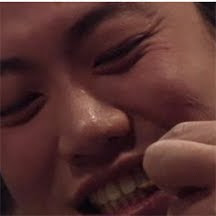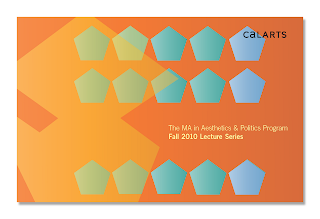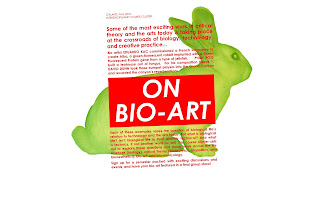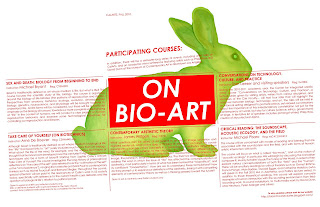Welcome! This blog was created to record the activities of the Fall 2010 interdisciplinary course cluster on bioart at the California Institute of the Arts. Although the cluster officially ended in December 2010, we will continue to use this blog to share ideas about bioart and announce events related to bioart at CalArts and in Los Angeles. During the Fall 2011 semester, this blog will be used to record the activities of the Body Cluster.
Monday, December 27, 2010
Wednesday, December 15, 2010
BIOCOUTURE
http://www.nytimes.com/interactive/2010/12/19/magazine/ideas2010.html#Biocouture
also interesting: anouk wipprecht's pseudomorphs:
and more:
Monday, December 13, 2010
Final gallery show
For more images, click here.


Friday, December 10, 2010

Thursday, December 9, 2010
BIOART GALLERY SHOW
Thursday, November 18, 2010
RESULTS VOICE EXPERIMENT
Wednesday, November 17, 2010
The 3rd I
NOVEMBER 16, 2010, 2:09 PM
Art that Looks Backward
By KATE TAYLOR
A New York University photography professor will have a camera surgically implanted in the back of his head for several months as part of an art project commissioned by the government of Qatar, The Wall Street Journal reported. The project, called “The 3rd I” and organized by a new Qatari museum called Mathaf: Arab Museum of Modern Art, will involve the camera taking pictures at one-minute intervals with the images being streamed to a computer database and then appearing in different sequences, some in real time, on monitors in an exhibition space in Doha between December and May.
According to The Journal, the professor, Wafaa Bilal, has offered to cover the camera with a lens cap when he is on the N.Y.U. campus, out of respect for students’ privacy, but the university may require him to turn the camera off. In a statement on Tuesday the university said it was in discussions with Mr. Bilal about to how to ensure that his camera would not take pictures in N.Y.U. buildings. Mr. Bilal, who was born in Iraq, has provoked controversy with earlier projects, including one in 2008 called “Virtual Jihadi,” in which he altered a video game to insert an avatar of himself as a suicide-bomber targeting George W. Bush.
More brain stuff
http://viralnet.net/homeandgarden/projects/brainhouse.html
Brainwave music, by David Rosenboom:
COMING UP
DECEMBER
Thursday, December 9th, 7:30-9:30pm, Gallery A116.
Opening reception for the bioart gallery show (Friday, December 3rd-Friday, December 10th) featuring work from students enrolled in at least one of the cluster courses.
Pizza and soda will be provided.
Phil Ross' Juggernaut (2004):
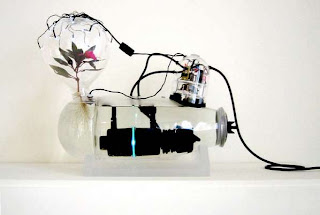
Tuesday, November 16, 2010
BRAIN TALK
MOLECULAR ANIMATION
Saturday, November 13, 2010
Wednesday, November 10, 2010
SEX AND DEATH VOICE EXPERIMENT
https://sites.google.com/a/calarts.edu/cssm265-experiment/
here's the introduction to the experiment:
Introduction
Thank you for logging into the” CSSM265 Sex and Death” voice experiment
Your voluntary participation is appreciated! The people who have provided their voice samples are volunteers and know what this experiment is about. Your answers are anonymous and the voice volunteers will never know how you responded to their voice. They will not even know in aggregate.
Please answer the questions honestly. You may leave questions blank if you do not want to answer them.
Please do not participate in this experiment if you are under 18 years old!
Click on "Take our Experiment" to continue. Instructions for participating in the experiment can be found on the next page.
Monday, November 8, 2010
TODAY!!

Biology, Technology, and the Arts
A symposium presented by
The Fall 2010 Interdisciplinary Course Cluster “On Bio-Art”
At the California Institute of the Arts
LOCATION: AHMANSON AUDITORIUM, MOCA GRAND AVENUE, LOS ANGELES--TRANSPORT TO MOCA LEAVING AT THE MAIN CALARTS ENTRANCE AT 2PM AND AT 3:30PM
Program
Afternoon Speakers
4:30pm: Michael Bryant, School of Critical Studies, CalArts
4:35pm: Martie Haselton, Communication Studies and Psychology, UCLA
http://www.sscnet.ucla.edu/comm/haselton/home.html
4:50pm: Philip Ross, Founding Director of CRITTER
http://billhoss.phpwebhosting.com/ross/index.php?id=1
5:05pm: Robert Mitchell, Department of English, Duke
http://english.duke.edu/people?Gurl=%2Faas%2FEnglish&Uil=rmitch&subpage=profile
5:20pm: Michael Pisaro, School of Music, CalArts
http://directory.calarts.edu/directory/michael-pisaro-0
5:35pm: Anne Marie Oliver, Intermedia and Contemporary Theory, PNCA
http://www.pnca.edu/programs/bfa/majors/intermedia.php
5:50-6:20pm: Discussion with the audience
6:20-7:30pm: Break
Evening Lecture
7:30pm: Arne De Boever, School of Critical Studies/MA in Aesthetics and Politics, CalArts
7:35pm: Catherine Malabou, Université Paris-X Nanterre and SUNY Buffalo
Saturday, November 6, 2010
Facebook page for Malabou lecture and Bioart Conference
http://www.facebook.com/event.php?eid=163848453648412
Miriam Nourí sent on this work, by Julianne Swartz:
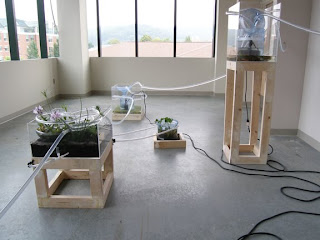
For more info, click here.
Friday, November 5, 2010
TRANSPORT TO MOCA
those of you who would like to catch a ride to MOCA on tuesday, november 9th to attend the afternoon conference on "biology, technology, and the arts" as well as the evening lecture by catherine malabou should gather on the steps at the main calarts entrance (in front of the blue wall) at 2pm OR at 3:30pm. several cars will be leaving at 2pm, and you might want to catch a ride with the early ones just to make sure you have a spot. most of the cars will be leaving at 3:30pm. please be punctual so that our drivers do not have to wait around.
if you have any questions about this, please contact the course cluster TA, justine de penning.
hope to see many of you there!
Tuesday, November 2, 2010
Enormous Microscopic Evening, with Phil Ross

Admission: Free!
Come down to the Hammer Museum on November 6th from 4-7 PM and get small in a big way at Enormous Microscopic Evening! This free event will celebrate and demonstrate the range of equipment people are using to explore the invisible, from state of the art futuristic equipment to home made one-of-a-kind technologies.
Observe mesmerizing and sublime live images created by experts, amateurs, and hobbyists who will share how they practice their craft. Live music will accompany your journey into the enormously microscopic, where you can see dancing DNA, view miniature life through the eye of an IMAX camera, and take home a portrait of your own cheek cell to hang on your fridge. What might a world with over a billion connected microscopes look like? Enormous Microscopic Evening will be demonstrating the possibilities of using cheap and powerful networked microscopes. Learn how “social microscopy” is being used in medicine, mapping and environmental safety, and changing the way we look at the whole world in the process.
Monday, November 1, 2010
EVENTS NEXT WEEK

On Monday, November 8th, Phil Ross and Rich Pell are speaking in Tom Leeser's "Conversations on Technology, Culture, and Practice" course. Time: 7pm. Location: A116. This event is open to ALL students participating in the cluster--and I'm sure you won't be turned away if you're not taking any of the cluster classes. This is a unique opportunity to find out about these artists' practices in the informal context of a class. Be there!
On Tuesday, November 9th, your afternoon and evening are already booked: you'll be traveling to the Museum of Contemporary Art on Grand Avenue, to attend a symposium on the crossover of biology, technology, and the arts today. Scientists, philosophers, and artists will gather to discuss topics relevant to the course cluster topic: bioart. Participants will include Phil Ross (CRITTER salon), Martie Haselton (UCLA), Robert Mitchell (Duke--author of a recent book titled Bioart and the Vitality of Media, which is featured on this blog), Anne Marie Oliver (PNCA), and others. In the evening, French philosopher Catherine Malabou will be giving a lecture titled "Plasticity: New Political Modes of Being." Professor Malabou is one of the major voices working in continental philosophy today--this is really an event that's not to be missed.
There will be vans going from CalArts to MOCA on Tuesday afternoon, so you do not have to worry about transport. More info about the vans will be posted here, so check in later this week for more information.
Sunday, October 24, 2010
Big Bambú
Visitors witness the continuing creation and evolving incarnations of Big Bambú as it is constructed throughout the spring, summer, and fall by the artists and a team of rock climbers. Set against Central Park and its urban backdrop, Big Bambú suggests the complexity and energy of an ever-changing living organism.
http://www.starnstudio.com/Big%20Bambu2.html
http://www.metmuseum.org/special/se_event.asp?OccurrenceId={9C6923D2-D348-4761-BEB3-A943934068D2}
Sunday, October 17, 2010
Manfred Max-Neef

ACKROYD & HARVEY
 Hi Everyone-
Hi Everyone-Friday, October 15, 2010
Phil Ross and Rich Pell visit IM
 http://vimeo.com/4104661
http://vimeo.com/4104661Rich Pell
Richard Pell is a founding member of the highly acclaimed art and engineering collective, the Institute for Applied Autonomy. His work with IAAincludes several robotic, web and biologically based projects that call into question the imperatives that drive technological development. IAA projects such as the robotic GraffitiWriter, iSee and TXTmob have been exhibited in art, activist and engineering contexts such as the ZKM in Karlsruhe, Mass MoCA, CAC in Cincinnati, Australian Center for the Moving Image, Aldrich Museum of Contemporary Art, Hackers On Planet Earth and the International Conference On Robotics And Automation. IAA projects have been chosen for an Award of Distinction and two Honorable Mentions at the Prix-Ars Electronica in Linz, Austria and were selected for RES Magazine’s 10 Best New Artists of 2005. His narrative and documentary videos explore the individual’s relationship to authority. His most recent video documentary entitled, Don’t Call Me Crazy On The 4th Of July, won the Best Michigan Director Award at the Ann Arbor Film Festival in 2005, took 1st prize at the Iowa International Documentary Film Festival has screened in numerous festivals internationally. In 2007 he was awarded a prestigious Rockefeller New Media Fellowship for the establishment of a new museum entitled The Center for PostNatural History.

For the past fifteen years I have been making research based artworks that place natural systems within a frame of social and historic contexts. While this often takes form as sculptural installations my recent work has included a trilogy of videos about microorganisms, founding and directing CRITTER- a salon for the natural sciences in San Francisco, and developing some LEED Transplutonic building materials. These diverse projects stem from my fascination with the interrelationships between human beings, technology and the greater living environment.
My personal drive for making work about the organic world is born from a lifetime interest in biology. While I was terrible in high-school science and math my education emerged through a more direct engagement with materials and practices; as a chef I began to understand biochemistry and laboratory methods, as a hospice caregiver I worked with life support technologies and environmental controls, and through my interest in wild mushrooms I learned about taxonomies, forest ecologies and husbandry. Engaging with the sciences through an every day practice is a route that is aesthetically, intellectually and symbolically rich. In my various projects I show what I find interesting about the natural world, and use the lens of human artifice to achieve a specific focus of that view.
Monday, October 11, 2010
Slavoj Zizek on Ecology
Saturday, October 9, 2010
THIS THURSDAY, SECOND CLUSTER NIGHT
Second cluster night, with Miranda Wright and Ian Garrett from the Center for Sustainable Practice in the Arts.
Pizza and soda will be provided.
Thursday, September 30, 2010
THIS THURSDAY, CAFE A, 7:30PM
Tuesday, September 28, 2010
Take Care of Yourself: Paul/Marcus Aurelius responses
Thanks!
Monday, September 27, 2010
Sunday, September 26, 2010
Friday, September 24, 2010
Thursday, September 23, 2010
TONIGHT
Cluster kick-off (first cluster night), with short presentations by the course cluster faculty.
Pizza and soda will be provided.
Spread the word!
Tuesday, September 21, 2010
Take Care of Yourself MA/MFA reading responses
Thanks, and see you in class tomorrow.
Friday, September 17, 2010
Events this week
Wednesday, September 22nd. Time TBA. **RESCHEDULED FOR WEDNESDAY, SEPTEMBER 29TH, 7-9PM.** Gallery A116:
Screening of Strange Culture by Lynn Hershman Lesson, a documentary/fiction film about the case of Steve Kurtz, an artist who was arrested for bioterrorism.
Thursday, September 23rd. 8-9pm, Gallery A116:
Cluster kick-off (first cluster night), with short presentations by the course cluster faculty.
Pizza and soda will be provided.
Spread the word!
Thursday, August 26, 2010
Aesthetics and Politics Lecture Series
Wednesday, August 18, 2010
New event
http://www.sustainablepractice.org/
For more info, see our events page.
Wednesday, August 11, 2010
Fallen Fruit at LACMA
Please join David Burns, Matias Viegener and Austin Young for drinks and an informal talk-- with a mysterious live apparition by Charlotte Cotton – to celebrate Fallen Fruit Presents the Fruit of LACMA
A collaboration between three artists founded in 2004, all of Fallen Fruit's work uses fruit as a lens. Fruit interests them in the way it spans history and different classes, ages, and ethnic groups; it’s everywhere, sometimes invisible but ubiquitous. Through it they find surprising and innovative ways to talk about land use, art history, social relations and neighborliness. Fallen Fruit's work includes photographs, videos, installations and participatory public events that express these ideas in dynamic ways.
EATLACMA is Fallen Fruit’s year-long project at LACMA that investigates food, art, culture and politics. It unfolds in three "acts," with artist gardens currently on view around the campus and an exhibition, The Fruit of LACMA, in which the artists curate pieces from the museum’s permanent collection in several media (painting, photography, and decorative arts) to examine the haunting persistence of fruit in art. It examines the symbolic and sociological aspects of fruit in art, from religious symbolism to embedded social messages. Included is a LACMA-commissioned piece from Fallen Fruit, a wall paper print of public fruit harvested on one day in Silver Lake, rendered in a traditional decorative pattern. For more information see fallenfruit.org and eatlacma.org
Thursday, August 12th, 5 to 7pm
Talk begins promptly at 5:30

Monday, August 9, 2010
GFP pigs
Sunday, August 8, 2010
Butterflies
http://www.martademenezes.com/
This is old news, but still relevant:
http://www.news.cornell.edu/releases/May99/Butterflies.bpf.html
"An increasingly popular commercial corn, genetically engineered to produce a bacterial toxin to protect against corn pests, has an unwanted side effect: Its pollen kills monarch butterfly larvae in laboratory tests, according to a report by Cornell University researchers."
The Cosmopolitan Chicken Project
http://www.koenvanmechelen.be/content/view/114/88889030/lang,en/
From the website:
"The Cosmopolitan Chicken project includes the worldwide experimental project with which Koen Vanmechelen hopes to develop a super-hybrid chicken. Crossbreeds clearly plays an essential role in Vanmechelen's work, not only in chickens but also in materials and disciplines. Topical themes such as genetic manipulation, cloning, globalisation and multiculturalness are found throughout his work. An important lateral project is the search for the Red Jungle Fowl, the primal chicken which is still found in Asia. Vanmechelen likes to describe his work in Hegelian terms: thesis, antithesis and synthesis. The chicken and the egg are a metaphor for the human race and art."

Tuesday, August 3, 2010
Acoustic ecology
Schafer's book is on the reading list for Michael's course.
Morton also discusses John Cage in this context:
Even Sonic Youth passes the revue. Thurston Moore's notion of "pastoral violence" is à propos:
What are hyperobjects?
"Alongside global warming, 'hyperobjects' will be our lasting legacy. Materials from humble Styrofoam to terrifying plutonium will far outlast current social and biological forms. We are talking about hundreds and thousands of years. Five hundred years from now, polystyrene objects such as cups and takeout boxes will still exist. Ten thousand years ago, Stonehenge didn't exist. Ten thousand years from now, plutonium will still exist.
Hyperobjects do not rot in our lifetimes. They do not burn without themselves burning (releasing radiation, dioxins, and so on). The ecological thought must think the future of these objects, these toxic things that appear almost more real than reality itself, like the acidic blood of the Alien in Ridley Scott's film, which burns through metal floors." (The Ecological Thought, 130)
It might be time to watch this again:
Monday, August 2, 2010
Bill Burns' Safety Gear for Small Animals
Robert Mitchell on bioart and media
In his book, Mitchell makes the case for Tom Leeser’s course, i.e. he builds a great argument as to why a course on bioart matters in the curriculum of the Center for Integrated Media. There’s a whole chapter on this in his book, but here’s what he has to say about it in his introduction:
“Bioart seems to me to be an especially useful object of analysis for this project of rethinking media for several reasons. First, insofar as bioart links artistic goals and techniques with biological technologies, bioartworks also frequently end up bringing together two quite different senses of media. On the one hand, bioart draws from the more familiar sense of ‘medium’ as a material means through which thoughts, information, images, sounds, colors, textures are stored and transmitted from one place or time to another (it is in this sense that one speaks of newspapers and television as instances of ‘mass media,’ for example). On the other hand, bioart also draws on the sense of ‘media’ used by biologists, for whom the term refers to fluids or solids that are employed to keep living cells developing, dividing, and transforming during the course of an experiment. Bioart links these two conceptions of media by situating biological media and technologies within a milieu—namely, an art gallery—that has traditionally been associated with the sense of media as a means for storage and communication.
Second, and equally significant, bioart produces in its ‘spectators’ an embodied sense of this link between these two senses of media, for by using living beings—or by revealing ways in which spectators are bound, beyond their control, to other forms of life—bioart frames spectators as themselves media for the transformative powers of life” (Bioart and the Vitality of Media, 11).
Mitchell will be speaking at our afternoon MOCA event on Tuesday, November 9th. CalArts will provide vans to facilitate your transport to the city.
The case of Steve Kurtz
A film has been made about the case (http://www.strangeculture.net/):
This film will be screened in Gallery A116 during the last full week of September (September 20th-September 24th). It will be discussed in a roundtable with course cluster faculty scheduled for Thursday, September 23rd, at A116.
Timothy Stock and Warren Heise made a graphic novel about the case titled Suspect Culture:
http://mitpress.mit.edu/catalog/item/default.asp?ttype=2&tid=10596
Thursday, July 29, 2010
Timothy Morton on Alba
"Is the horror of this art simply the shock value derived from the clichéd Frankenstein interpretation--that science has overstepped the bounds of human propriety [see clip below]? Or is it the revelation that if you can do that to a rabbit, then there wasn't that much of a rabbit in the first place? If you really could put duck genes in rabbit genes and rabbit genes in duck genes, it would give a new spin to Joseph Jastrow's duck-rabbit illusion [reproduced below]. You really would be able to see a duck or a rabbit at the same time, because you never really saw a duck or a rabbit in the first place. There are less ducks and rabbits not in number but in essence. We're faced with the extraordinary fact of increasing detail and vanishing fullness. The ecological thought makes our world vaster and more insubstantial at the same time." (The Ecological Thought, 36-7)
Morton is speaking at CalArts on Thusday, October 7th.
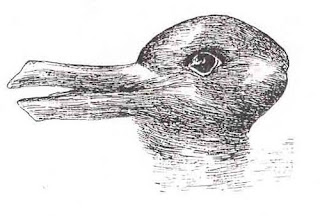
Here's the image that Michael Bryant refers to in the third comment on this post:
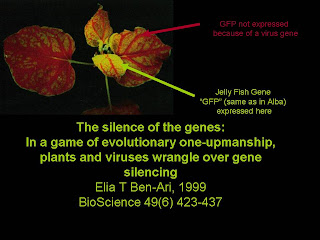
Wednesday, July 28, 2010
EATLACMA
http://eatlacma.org/about/
The folks from Fallen Fruit will come speak in Tom Leeser's course on Monday, October 4th.
Some new events
"i will be down in LA a few days before your november 9th conference, curating an event at the hammer museum called 'enormous microscopic evening' that is part of my CRITTER salon. this will take place on november 6th and will bring together numerous scientists, technologists and amateurs to show off their instruments. the day before the event i will be organizing a workshop at machine project, with rich pell teaching folks how to make web cam based microscopes and myself demonstrating how to recreate the original leeuwenhoek device. i will send you more on all of this as we get our press machine in order."
For more info, see our events page.

Monday, July 19, 2010
On the 24700 blog
Monday, July 12, 2010
Saturday, July 10, 2010
Wednesday, July 7, 2010
Is all biology art?
However, Kac’s rabbit could already be considered an example of bioart before Kac’s intervention: its genetic material is a complex mix of the genetic material of two other rabbits. What goes in as a carrot on one end of the rabbit comes out looking like something entirely different on the other end. Surely digestion also is an example of bioart? Surely Wim Delvoye’s Cloaca factory (http://www.wimdelvoye.be/cloacafactory.php) qualifies? In a short essay called “In Praise of Profanation”, Giorgio Agamben recalls Italo Calvino’s statement that “feces are a human production just like any other, only there has never been a history of them”…
This seems to lead to the conclusion that there is no biology that exists separately from art. Does that mean that all biology is art? What would be the consequences of this for our understanding of biology and art?







